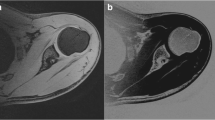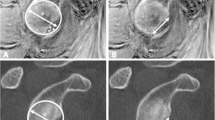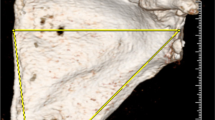Abstract
Objective
To utilize the 3D inversion recovery prepared ultrashort echo time with cones readout (IR-UTE-Cones) MRI technique for direct imaging of lamellar bone with comparison to the gold standard of computed tomography (CT).
Materials and methods
CT and MRI was performed on 11 shoulder specimens and three patients. Five specimens had imaging performed before and after glenoid fracture (osteotomy). 2D and 3D volume-rendered CT images were reconstructed and conventional T1-weighted and 3D IR-UTE-Cones MRI techniques were performed. Glenoid widths and defects were independently measured by two readers using the circle method. Measurements were compared with those made from 3D CT datasets. Paired-sample Student’s t tests and intraclass correlation coefficients were performed. In addition, 2D CT and 3D IR-UTE-Cones MRI datasets were linearly registered, digitally overlaid, and compared in consensus by these two readers.
Results
Compared with the reference standard (3D CT), glenoid bone diameter measurements made on 2D CT and 3D IR-UTE-Cones were not significantly different for either reader, whereas T1-weighted images underestimated the diameter (mean difference of 0.18 cm, p = 0.003 and 0.16 cm, p = 0.022 for readers 1 and 2, respectively). However, mean margin of error for measuring glenoid bone loss was small for all modalities (range, 1.46–3.92%). All measured ICCs were near perfect. Digitally registered 2D CT and 3D IR-UTE-Cones MRI datasets yielded essentially perfect congruity between the two modalities.
Conclusions
The 3D IR-UTE-Cones MRI technique selectively visualizes lamellar bone, produces similar contrast to 2D CT imaging, and compares favorably to measurements made using 2D and 3D CT.






Similar content being viewed by others
References
Bhatia S, Ghodadra NS, Romeo AA, Bach BR, Verma NN, Vo ST, et al. The importance of the recognition and treatment of glenoid bone loss in an athletic population. Sports Health. 2011;3(5):435–40.
Saliken DJ, Bornes TD, Bouliane MJ, Sheps DM, Beaupre LA. Imaging methods for quantifying glenoid and Hill–Sachs bone loss in traumatic instability of the shoulder: a scoping review. BMC Musculoskelet Disord. 2015;16:164.
Bishop JY, Jones GL, Rerko MA, Donaldson C, Group MS. 3-D CT is the most reliable imaging modality when quantifying glenoid bone loss. Clin Orthop Relat Res. 2013;471(4):1251–6.
Chang EY, Du J, Chung CB. UTE imaging in the musculoskeletal system. J Magn Reson Imaging. 2015;41(4):870–83.
Chang EY, Du J, Bae WC, Chung CB. Qualitative and quantitative ultrashort echo time imaging of musculoskeletal tissues. Semin Musculoskelet Radiol. 2015;19(4):375–86.
Carl M, Bydder GM, Du J. UTE imaging with simultaneous water and fat signal suppression using a time-efficient multispoke inversion recovery pulse sequence. Magn Reson Med. 2016;76(2):577–82.
Gurney PT, Hargreaves BA, Nishimura DG. Design and analysis of a practical 3D cones trajectory. Magn Reson Med. 2006;55(3):575–82.
Chen J, Chang EY, Carl M, Ma Y, Shao H, Chen B, et al. Measurement of bound and pore water T1 relaxation times in cortical bone using three-dimensional ultrashort echo time cones sequences. Magn Reson Med. 2017;77(6):2136–45.
Li S, Ma L, Chang EY, Shao H, Chen J, Chung CB, et al. Effects of inversion time on inversion recovery prepared ultrashort echo time (IR-UTE) imaging of bound and pore water in cortical bone. NMR Biomed. 2015;28(1):70–8.
Horch RA, Gochberg DF, Nyman JS, Does MD. Clinically compatible MRI strategies for discriminating bound and pore water in cortical bone. Magn Reson Med. 2012;68(6):1774–84.
Du J, Carl M, Bydder M, Takahashi A, Chung CB, Bydder GM. Qualitative and quantitative ultrashort echo time (UTE) imaging of cortical bone. J Magn Reson. 2010;207(2):304–11.
Han M, Rieke V, Scott SJ, Ozhinsky E, Salgaonkar VA, Jones PD, et al. Quantifying temperature-dependent T1 changes in cortical bone using ultrashort echo time MRI. Magn Reson Med. 2015;74(6):1548–55.
Huysmans PE, Haen PS, Kidd M, Dhert WJ, Willems JW. The shape of the inferior part of the glenoid: a cadaveric study. J Shoulder Elb Surg. 2006;15(6):759–63.
Landis JR, Koch GG. The measurement of observer agreement for categorical data. Biometrics. 1977;33(1):159–74.
Pauly JM, Conolly SI, Nishimura D, Macovski A. Slice-Selective Excitation for Very Short T2 Species. Amsterdam: ISMRM 8th Scientific Meeting & Exhibition; 1989. p. 28.
Huijsmans PE, Haen PS, Kidd M, Dhert WJ, van der Hulst VP, Willems WJ. Quantification of a glenoid defect with three-dimensional computed tomography and magnetic resonance imaging: a cadaveric study. J Shoulder Elb Surg. 2007;16(6):803–9.
Gyftopoulos S, Hasan S, Bencardino J, Mayo J, Nayyar S, Babb J, et al. Diagnostic accuracy of MRI in the measurement of glenoid bone loss. AJR Am J Roentgenol. 2012;199(4):873–8.
Lee RK, Griffith JF, Tong MM, Sharma N, Yung P. Glenoid bone loss: assessment with MR imaging. Radiology. 2013;267(2):496–502.
Stecco A, Guenzi E, Cascone T, Fabbiano F, Fornara P, Oronzo P, et al. MRI can assess glenoid bone loss after shoulder luxation: inter- and intra-individual comparison with CT. Radiol Med. 2013;118(8):1335–43.
Rerko MA, Pan X, Donaldson C, Jones GL, Bishop JY. Comparison of various imaging techniques to quantify glenoid bone loss in shoulder instability. J Shoulder Elb Surg. 2013;22(4):528–34.
Moroder P, Resch H, Schnaitmann S, Hoffelner T, Tauber M. The importance of CT for the pre-operative surgical planning in recurrent anterior shoulder instability. Arch Orthop Trauma Surg. 2013;133(2):219–26.
Gyftopoulos S, Yemin A, Mulholland T, Bloom M, Storey P, Geppert C, et al. 3DMR osseous reconstructions of the shoulder using a gradient-echo based two-point Dixon reconstruction: a feasibility study. Skelet Radiol. 2013;42(3):347–52.
Gyftopoulos S, Beltran LS, Yemin A, Strauss E, Meislin R, Jazrawi L, et al. Use of 3D MR reconstructions in the evaluation of glenoid bone loss: a clinical study. Skelet Radiol. 2014;43(2):213–8.
Stillwater L, Koenig J, Maycher B, Davidson M. 3D-MR vs. 3D-CT of the shoulder in patients with glenohumeral instability. Skelet Radiol. 2017;46(3):325–31.
De Wilde LF, Berghs BM, Audenaert E, Sys G, Van Maele GO, Barbaix E. About the variability of the shape of the glenoid cavity. Surg Radiol Anat. 2004;26(1):54–9.
Acknowledgements
The authors acknowledge support from the VA Clinical Science Research and Development Service (I01CX001388), NIH (R01AR062581 and R01AR068987), and GE Healthcare.
Author information
Authors and Affiliations
Corresponding author
Ethics declarations
Conflict of interest
There are no conflicts of interest to disclose related to this work.
Rights and permissions
About this article
Cite this article
Ma, Yj., West, J., Nazaran, A. et al. Feasibility of using an inversion-recovery ultrashort echo time (UTE) sequence for quantification of glenoid bone loss. Skeletal Radiol 47, 973–980 (2018). https://doi.org/10.1007/s00256-018-2898-4
Received:
Revised:
Accepted:
Published:
Issue Date:
DOI: https://doi.org/10.1007/s00256-018-2898-4




